When I first started kayaking, I was curious about what kayaks are made of and how the materials impact the performance and durability of these versatile watercraft. It’s fascinating to learn about the different materials used to construct kayaks and how they cater to a variety of needs, such as stability, weight, speed, and resistance.
Traditionally, kayaks were crafted from wood and animal skins, but as technology advanced, so did the materials used in kayak manufacturing. Today, you’ll find them made from a variety of materials like polyethylene, ABS plastic, and composite materials such as fiberglass, carbon fiber, and Kevlar. Each of these materials has its own distinct advantages and disadvantages, which can greatly affect your kayaking experience.
For instance, polyethylene kayaks are affordable and durable, making them popular among recreational users. On the other hand, ABS plastic offers a balance of durability, lightness, and UV resistance, which is ideal for enthusiasts seeking more advanced performance.
Lastly, composite kayaks—crafted from fiberglass, carbon fiber, or Kevlar—provide the highest level of performance but are also the most expensive option.
Contents
Contents
Exploring Kayak Materials
When considering what are kayaks made of, it’s important to understand that there are several different materials commonly used in kayak construction. These materials not only determine the overall durability and performance of a kayak but also affect its weight, maneuverability, and price. In this section, we’ll break down the key materials used in kayak manufacturing.

One popular material in modern kayak construction is polyethylene, which is a type of plastic. Polyethylene kayaks offer several advantages, including:
- Affordability
- Durability
- Resistance to impact and wear
However, there are some drawbacks to polyethylene, such as:
- Heavier weight compared to other materials
- Susceptibility to UV damage and deformation from heat
Another common material used in kayak manufacturing is composite, which typically consists of layers of fiberglass, carbon fiber, or Kevlar fabric with a resin binding. Composite kayaks have a range of benefits, including:
- Lighter weight than polyethylene
- Greater stiffness and performance
- Aesthetic appeal and customization options
But, composite kayaks also come with some downsides, such as:
- Higher cost
- Less resistant to impact damage
In addition to polyethylene and composite materials, thermoformed ABS plastic has also gained popularity in kayak construction. Thermoformed ABS kayaks tend to be lighter than polyethylene models and more resistant to UV damage.
While the above materials are the most common, there are also some lesser-known materials used in kayak production, such as:
- Wood: Traditional and visually appealing, but less common and require more maintenance
- Inflatable materials: Lightweight and easily portable, but less rigid and durable
When taking into account the different kayak materials, it’s essential to weigh the specific needs of your kayaking adventures. Key factors to consider when choosing a kayak material include:
- Budget: Opt for materials like polyethylene or inflatable materials for more affordable options
- Performance: If you’re looking for a high-performance kayak, a composite model might be your best choice
- Durability and maintenance: Carefully consider the maintenance and durability of a material before making a decision
Wooden Kayaks: Traditional Craftsmanship
Wooden kayaks have a long and rich history that dates back thousands of years. They are the epitome of traditional craftsmanship and showcase the skills of artisans who both understood the qualities of wood and the demands placed upon kayaks by nature. So, when you ask, “What are kayaks made of?”, wooden kayaks are surely one of the most fascinating answers.
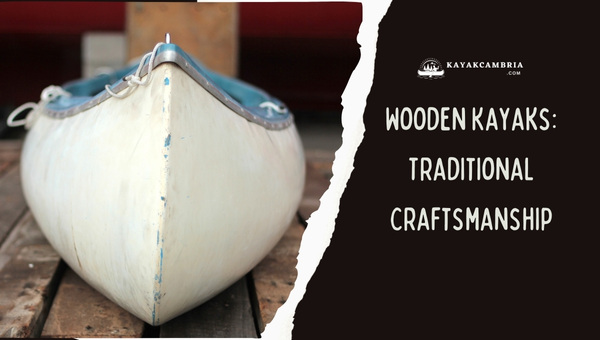
Wooden kayaks have been used by indigenous people, mainly the Inuit and the Aleut, in the Arctic regions. These native people crafted their kayaks using a wooden frame typically made from driftwood or local trees, like cedar or spruce.
The lightweight frame would then be covered with either animal skins or various types of bark to provide a watertight seal. The choice of animal skin varied between different cultures, but sealskin was often preferred due to its durability and water resistance.
Here’s a quick summary of the traditional materials used in wooden kayaks:
- Wooden Frame: Driftwood, cedar, or spruce
- Skin Covering: Animal skins (e.g. sealskin) or bark
Some features that make wooden kayaks highly sought after include the natural elegance that wooden materials offer, smooth lines, and lightweight construction. On top of these benefits, the flexibility of the material also allows wooden kayaks to absorb vibrations and minimize the effect of any impact. This makes them a prime choice for those seeking a highly maneuverable, comfortable, and aesthetically pleasing kayak.
Advancements in technology have also paved the way for more modern wooden kayaks. These use high-quality marine plywood combined with epoxy resins and fiberglass cloth, to create a construction method widely known as the “stitch-and-glue” technique. This modern approach makes wooden kayaks more durable and weather-resistant while remaining lightweight.
Here’s a comparison of traditional and modern wooden kayaks:
| Wooden Kayak Construction | Traditional | Modern |
| Materials | Driftwood, cedar, spruce, animal skins, bark | Marine plywood, epoxy, fiberglass cloth |
| Advantages | Lightweight, flexible, elegant | Lightweight, durable, flexible, weather-resistant |
Wooden kayaks represent a unique blend of artistry and engineering that few other materials can emulate. They provide both elegant aesthetics and practical functionality, and their history and craftsmanship continue to fascinate those interested in kayaking.
Fiberglass Kayaks: Light and Durable
One of the main materials used in kayak manufacturing is fiberglass, known for its lightweight and durability. When people ask, “What are kayaks made of?” fiberglass is often one of the top answers. In this section, I’ll delve into the characteristics of fiberglass kayaks, what makes them popular, and their advantages compared to other types of kayaks.
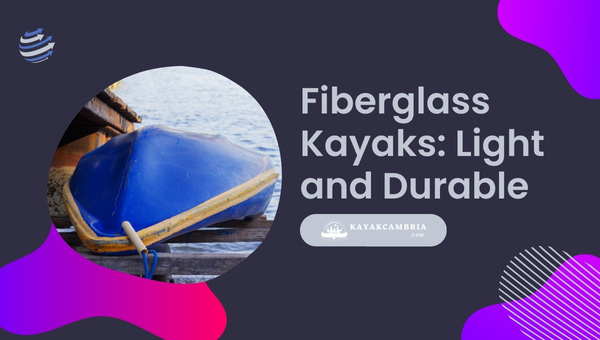
Fiberglass is made by combining glass fibers with resin, creating a sturdy and lightweight material perfect for high-performance kayaks. The construction process entails layers of glass fibers laid down in a mold, which are then saturated with resin. This allows for both strength and flexibility, making fiberglass kayaks ideal for various water activities.
Some benefits of fiberglass kayaks include:
- Lightweight: Fiberglass kayaks are generally lighter than polyethylene or plastic kayaks. This makes them easier to lift, carry, and transport.
- Durability: They’re able to withstand harsh environments and are less likely to crack or break when involved in an impact.
- Performance: Fiberglass kayaks are highly responsive, allowing for better maneuverability and control when paddling.
- Easy to repair: If damaged, fiberglass kayaks can often be repaired relatively easily compared to other materials.
However, along with these benefits come a few drawbacks. Fiberglass kayaks tend to be more expensive than their plastic counterparts, as the materials and labor involved in their construction are costlier. Additionally, while they are durable, they may not be the best choice for beginners, as these kayaks can be more susceptible to scratches and damage if not handled properly.
In terms of maintenance, it’s essential to keep fiberglass kayaks clean and check for any damage regularly. This can be done by rinsing the kayak with fresh water after each use and storing it in a cool, dry place away from direct sunlight to prevent any UV degradation.
If you notice any minor scratches, they can usually be buffed out with fine grit sandpaper, while more extensive damage may require professional repair.
To summarize, fiberglass kayaks are light and durable, making them a popular choice among water enthusiasts. Their combination of performance, maneuverability, and responsiveness has led to their widespread use in various water activities.
When considering what type of kayak to invest in, fiberglass is definitely a material worth considering – as long as you’re prepared to handle the little extra care and expense that comes along with it.
Plastic Kayaks: The Affordable Choice
In the world of kayaking, one question I get asked frequently is, “What are kayaks made of?” While there are several materials used in kayak construction, including wood, fiberglass, and composites, plastic kayaks have become quite popular because of their affordability and durability.
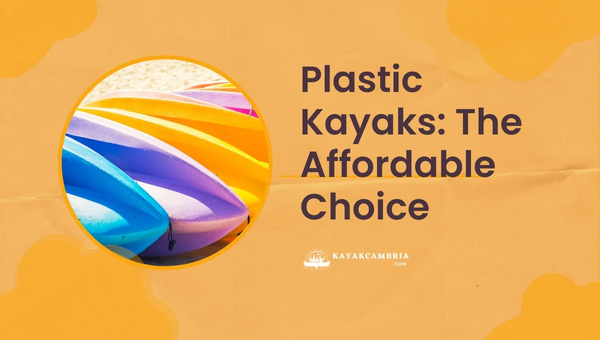
First, let’s discuss the type of plastic used in these kayaks. It’s a material called polyethylene, which is a lightweight, flexible, and highly durable type of plastic. Manufacturers use three main types of polyethylene for kayak production:
- Low-Density Polyethylene (LDPE)
- High-Density Polyethylene (HDPE)
- Super-Linear Polyethylene (SLE)
Below is a table that displays the main differences between these three types:
| Type | UV Resistance | Puncture Resistance | Repairability | Weight |
| LDPE | Low | Moderate | Easy | Light |
| HDPE | Moderate | High | Moderate | Heavy |
| SLE | High | Very High | Difficult | Moderate |
Most plastic kayaks are made from either HDPE or SLE. Both materials provide excellent durability, making them suitable for a variety of water conditions and activities. They’re also relatively low maintenance compared to their fiberglass or wooden counterparts.
So why choose plastic kayaks? Here are some of their advantages:
- Affordability: Plastic kayaks are less expensive than other types, making them accessible to those with tighter budgets. They’re perfect for beginners or occasional kayakers.
- Durability and Longevity: Polyethylene is extremely tough, making plastic kayaks resistant to impacts, abrasions, and punctures.
- Low-Maintenance: Not much is required to keep a plastic kayak in good shape, as they’re resistant to harsh environmental conditions and don’t need periodic refinishing or maintenance.
Of course, like any other material, plastic kayaks do have some drawbacks:
- Weight: Plastic kayaks can be relatively heavy, especially those made of HDPE. This might make transportation or handling more difficult for some.
- Limited Aesthetic Appeal: Plastic kayaks might not have the same visual appeal as their wooden or fiberglass counterparts.
- Environmental Concerns: The production and disposal of plastics have potential environmental impacts.
It’s essential to weigh the pros and cons when deciding if a plastic kayak is right for you. Each type of material offers different benefits and drawbacks, depending on your preferences, budget, and kayaking experience. But when it comes to affordability and durability, plastic kayaks are undoubtedly a solid and practical choice.
Composite Kayaks: Lightweight Performance
Among the various materials used in kayak construction, composite materials stand out for their lightweight yet high-performance characteristics. In this section, I’ll delve into the fascinating world of composite kayaks and what sets them apart from their counterparts.
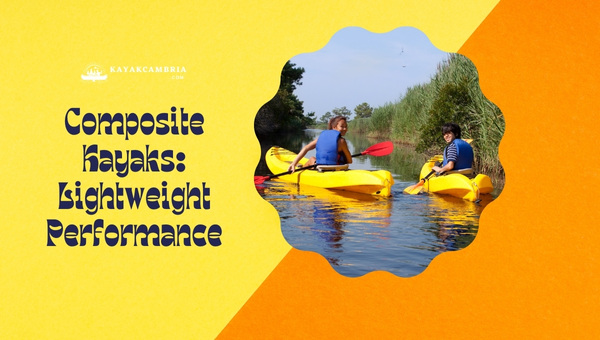
Composite kayaks are primarily crafted from fiberglass, carbon fiber, or a blend of the two, known as kevlar. Fiberglass kayaks, which are more affordable than carbon fiber models, offer exceptional durability, lightweight construction, and excellent hydrodynamics.
Carbon fiber kayaks, on the other hand, are known for their extreme lightness and remarkable strength. Finally, kevlar composite kayaks provide a perfect balance of weight, rigidity, and durability, making them popular among experienced paddlers.
Let’s take a closer look at the key benefits of composite kayaks:
- Weight: Composite materials are incredibly lightweight, which translates to easier handling, faster acceleration, and a more enjoyable paddling experience. Less weight means less effort, allowing you to cover greater distances with ease.
- Performance: The rigidity of composite materials contributes to efficient energy transfer, so each paddle stroke propels the kayak farther. Additionally, composite kayaks are designed with a smooth hull finish which reduces water resistance, enhancing speed, and tracking capabilities.
- Customization: Since composite materials can be molded into various shapes, these kayaks often feature customizable designs that cater to specific uses, styles, preferences, and needs of the paddler.
However, there are a few trade-offs to consider with composite kayaks:
- Cost: Composite materials tend to be more expensive than their plastic or inflatable counterparts, making them less accessible for beginner kayakers or those on a tight budget.
- Durability: While composite kayaks are quite strong, they may be more susceptible to damage from impact, such as hitting rocks, compared to plastic kayaks. That said, they can be repaired, but it requires specialized knowledge.
To sum up, composite kayaks excel in their lightweight and high-performance features. Although they may not be the most budget-friendly option, many kayakers find the benefits justify the investment. When you’re choosing a kayak, it’s essential to consider your needs, skill level, and preferences to find the perfect match for your paddling adventures.
Inflatable Kayaks: Portable and Versatile
When it comes to versatility and portability, inflatable kayaks are hard to beat. They’re a popular choice for people who don’t have the space to store a hard-shelled kayak or who want to take their kayak on trips, like camping or hiking. But exactly what are kayaks made of when it comes to inflatable versions?

Inflatable kayaks are made from durable, lightweight materials that can withstand the elements and survive accidental punctures. The most common materials used include:
- PVC (Polyvinyl Chloride): This is the most popular material choice for inflatable kayaks due to its affordability, flexibility, and durability. The downside to PVC is that it’s more susceptible to UV degradation and chemical exposure, so proper care and storage are essential.
- Hypalon: Also known as CSM (chlorosulfonated polyethylene), Hypalon is a heavier and more expensive material than PVC, but it offers superior resistance to UV rays, chemicals, and abrasions. Hypalon kayaks are known to last for years without significant signs of aging.
- Nitrilon: This material is a combination of rubber and fabric that is highly resistant to punctures, abrasions, and UV damage. Nitrilon is lighter and more eco-friendly than PVC, but it usually comes with a higher price tag.
As for the construction of inflatable kayaks, there are different styles and designs:
- Single-layer Construction: This budget-friendly option has just one layer of material, typically PVC, which is welded or glued together to create the kayak’s structure. While more affordable, single-layer kayaks are prone to punctures and damage.
- Multi-layer Construction: These kayaks have two or more layers of material, providing added durability and puncture resistance. They may feature a combination of the materials mentioned earlier, such as an outer Hypalon layer and an inner PVC layer.
Inflatable kayaks come in a variety of configurations, including tandem and solo options. They are also available in different shapes and hull designs to suit various purposes, such as:
- Sit-on-top Kayaks: Ideal for beginners and recreational paddlers, sit-on-top inflatable kayaks offer excellent stability and easy entry and exit.
- Sit-inside Kayaks: With a more enclosed design, sit-inside inflatable kayaks are suitable for paddlers who prefer a cockpit-style experience and want more protection from the elements.
- Whitewater Kayaks: Designed specifically for navigating rough water, these inflatable kayaks have a shorter, wider shape and enhanced stability to handle challenging rapids.
- Touring Kayaks: For long-distance paddling and exploration, touring inflatable kayaks have a sleeker, longer design to improve speed and tracking.
Overall, inflatable kayaks are incredibly versatile and offer numerous benefits to paddlers of different skill levels and interests. The key is to choose the right materials, construction, and design to suit your specific needs and preferences.
Carbon Fiber Kayaks: Expensive but Fast
Speaking of different materials that kayaks are made of, one that stands out as a premium option is carbon fiber. It’s true that carbon fiber kayaks can be expensive, but there are some significant benefits to justify the higher price tag. In this section, I’ll discuss these benefits and explore why carbon fiber has become a popular choice for some kayaking enthusiasts.

Lightweight but strong is the primary characteristic of carbon fiber, and it’s a major reason why it’s used in the construction of kayaks. With a lower weight, your kayak will glide through the water more easily, allowing for faster speeds and enhanced performance. This is particularly appealing for those who paddle over long distances or are competing in races.
Still, you might be wondering about the durability of a lightweight material like carbon fiber. Frankly, it’s quite sturdy, and it can withstand impacts without any significant damage. That being said, if you plan on taking your kayak through rough waters or rocky areas, it’s essential to handle it with care.
While carbon fiber kayaks are definitely top-tier in terms of quality, let’s compare them to their more affordable counterparts:
| Material | Weight | Durability | Costs |
| Polyethylene | Average to heavy | Highly durable | Low to moderate |
| ABS | Moderate | Durable | Moderate |
| Carbon Fiber | Lightweight | Moderate to durable | Moderate to high |
Here are some additional benefits of carbon fiber kayaks:
- Resistant to harsh environmental conditions: Carbon fiber can endure extreme temperatures, humidity, and UV exposure, ensuring a longer lifespan for your kayak.
- Customizability: When it comes to design, carbon fiber can be molded and tailored to meet the specific needs and preferences of the paddler.
- Aesthetic appeal: Last but not least, carbon fiber kayaks are known for their sleek, modern appearance that makes them stand out from their counterparts.
Carbon fiber kayaks are the top choice for those seeking speed, lightweight handling, and a sleek design. However, it’s worth noting that these benefits come at a higher cost compared to other materials like polyethylene and ABS. So when considering what kayaks are made of, take into account your personal needs, preferences, and budget before making a final decision.
Kevlar Kayaks: Lightweight and Tough
In the world of kayaking, one material that has gained popularity for its strength and lightweight properties is Kevlar. When discussing what are kayaks made of, I cannot ignore this exceptional material that has made a significant impact on the kayak manufacturing industry. Essentially, Kevlar is a synthetic fiber known for its strength-to-weight ratio, making it an ideal choice for constructing kayaks.
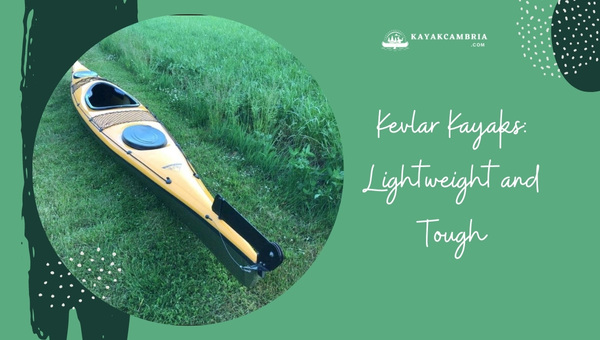
The secret behind Kevlar’s strength lies in its molecular structure. Resembling a spider’s web, this structure forms powerful bonds that contribute to the material’s incredible durability. Additionally, Kevlar boasts extreme resistance to abrasion and impacts, ensuring that your kayak can withstand rough conditions and last for years to come.
One of the prime advantages of using Kevlar for kayak construction is its lightweight nature. Compared to other materials such as fiberglass or polyethylene, it’s significantly lighter, typically resulting in a weight reduction of around 20% to 30%. This makes Kevlar kayaks easier to handle and transport, both in and out of the water.
| Material | Weight Reduction |
| Fiberglass | 0% |
| Polyethylene | 0% |
| Kevlar | 20-30% |
Some other benefits of Kevlar kayaks include:
- Enhanced speed: With a lighter weight, Kevlar kayaks allow for greater speed and agility in the water.
- Improved portability: The reduced weight allows for much easier transportation and handling of the kayak.
- Increased durability: The sturdy nature of Kevlar ensures a longer-lasting kayak that can endure the wear and tear of various water conditions.
While Kevlar kayaks provide numerous advantages, it’s essential to understand there are also some downsides:
- Cost: Kevlar kayaks tend to be more expensive than other materials, which can be a drawback for budget-conscious individuals.
- Repair difficulty: Repairing Kevlar can be challenging, as it requires specialized knowledge and materials.
Even with these drawbacks, Kevlar kayaks remain an excellent option for many. If you’re seeking a lightweight and robust kayak, Kevlar might be just what you’re looking for. But it’s essential to weigh the pros and cons to ensure it’s the right choice for your needs and budget.
Concluding Remarks
It’s been an illuminating journey exploring what kayaks are made of. Several materials are used in the manufacturing of these versatile watercraft, each bringing its own unique benefits and drawbacks. Some of the most common materials found in the construction of kayaks include:
- Polyethylene
- Royalex
- Thermoformed ABS
- Composite materials like fiberglass, carbon fiber, and Kevlar
The type of material used in a kayak relies heavily on factors such as purpose, skill level, budget, and personal preference.
To recap, here are the main highlights of each material used in kayaks:
- Polyethylene: Affordable, durable, and easy to repair, polyethylene is a popular choice for entry-level and recreational kayakers. However, it’s heavier than other materials and susceptible to warping.
- Royalex: Lightweight and flexible, Royalex is favored for its excellent impact resistance, making it ideal for whitewater kayaking. But, it’s becoming increasingly rare and costs more than polyethylene.
- Thermoformed ABS: Similar to Royalex, thermoformed ABS combines the best of both worlds. It’s lighter than polyethylene, yet more affordable than composite materials. Worth considering for its balance of durability, cost, and weight.
- Composite materials: Fiberglass, carbon fiber, and Kevlar are considered high-end materials, offering top performance and lightweight characteristics. Kayaks made from these materials are more expensive but provide an incomparable paddling experience.
Ultimately, understanding the different materials used to construct kayaks and their distinct advantages is essential when deciding on the perfect kayak for your needs. I hope this article has provided valuable insights into what kayaks are made of and will aid you in making an informed decision in your quest for the ideal watercraft.

